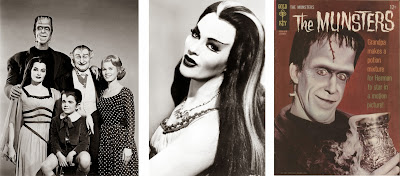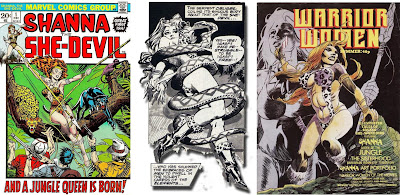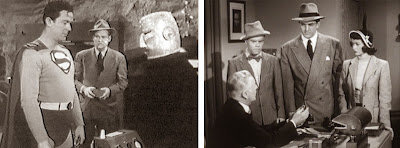As I've recounted in an earlier post on this blog, the biggest cause for excitement for me in 1965 was the imminent arrival of Batman at my local ABC Minors Saturday morning pictures. Not in person, of course, just in the form of the 1943 Batman movie serial.
 |
| "Careful what you say, fellas ... you never know who may be listening. Now let's get this stolen money divided up ..." |
I've since managed to get DVDs of both the Batman serials and, given when they were made, they both hold up pretty well. I guess for contemporary tastes, these old series must seem pretty repetitive. The first five minutes and the last five minutes are taken up with a recaps and previews of the episodes on either side. But we should remember that these episodes were never intended to be viewed immediately one after the other. Audiences in the 1930s and 1940s would go to the pictures more than once a week. It was their television, and they would have been exposed to a serial chapter on pretty much every visit. So keeping the storylines straight in their heads would have been tough without the constant recaps.
The important point is that Hollywood then, as now, thought of the comics (both newspaper and comic book) and pulps as generous sources of characters and ideas. The result was that these characters were kept uppermost in the public consciousness and, even if only the junior members of the audience went out and bought copies, it added up to sales.
The downside was that the flavour of the adventures portrayed in the serials was more serial than comic book. The superheroes only ever battled thugs in suits and fedora hats, whether fifth columnists, mad scientists or just plain old crooks. There was no Joker, Mr Mind or Red Skull going in in the serials.
The first comic book superhero serial to make it to the screen was The Adventures of Captain Marvel in 1941. It was supposed to have been a Superman serial, but DC/National were giving Republic the runaround during negotiations for the rights, so the studio simply approached Fawcett and did a deal with them instead. It would be almost 10 years before Superman made it to the screen after that lapse in judgement.
 |
| Cowboy actor Tom Tyler made a pretty good Captain Marvel in the 1941 serial. |
 |
| The first chapter of The Mysterious Doctor Satan was titled "Return of the Copperhead", even though he'd technically never been away. |
 |
| Bob Wayne (Robert Wilcox), descendent of an old West outlaw, puts on the chainmail mask and battles the thugs of Doctor Satan. |
WHAT'S ON TELLY, THEN?
That's not to say there was nothing on tv to capture my imagination. Probably my favourite show was My Favourite Martian (1963). The premise was almost the same as Superman ... an alien - in this case a martian called Exodus - crash-lands on Earth and newspaper reporter Tim O'Hara takes him in while the spacecraft is under repair. The gimmick is that O'Hara is always trying to out Exodus, but the alien outwits him at every turn, using his extraterrestrial (super)powers of invisibility, levitation and mind-reading. Character actor Ray Walston played the visitor and Bill Bixby, who would have another brush with superpowers in the next decade, played the reporter. |
| The martian ship looked barely big enough to carry a baby, let alone a grown man/martian. But the show was a big success with us kids, and of course there was a Gold Key comic book version, as well. |
I only have vague recollections of the Invisible Man tv series, but I do remember it scared the daylights out of me when I was about nine. Particularly the title sequence, which I would watch from behind the living room door (we were too poor to have a sofa).
 |
| I haven't seen the show since the early 1960s, but I remember the special effects for The Invisible Man (1958) being quite convincing. I'm probably mistaken ... |
And on that cue, sliding doors would part to reveal a couple of really creepy, spiky robots that didn't talk but did glower effectively.
And I liked The Munsters as well ... by 1965, I was already a big fan of Famous Monsters of Filmland and I felt very clever knowing that the Munster family were all based on the classic Universal monsters. Fred Gwynne and Al Lewis had been in the earlier Car 54 Where Are You?, which I had been aware of but hadn't followed.
Of course, I much preferred them as The Frankenstein Monster and Dracula than as two bumbling New York police officers. I also loved the way the gorgeous Pat Priest as Marilyn Munster was seen as hideously deformed by the family. And, weird child that I was, I thought there was something strangely attractive about Yvonne de Carlo as Lily Munster ...
And the last pre-Batman show I especially enjoyed was The Avengers. Like all the shows I've mentioned here already, The Avengers managed to pack in elements of science-fiction, horror and fantasy, though it was - at least, on the surface - an espionage series, leading some fans to later dub it "Spy-Fi".
There had been spy shows before. Top Secret (with its infuriatingly catchy theme tune "Sucu-Sucu"), for example, and the grim and gritty Danger Man with Patrick McGoohan, but for kids of comic-reading age, The Avengers was the perfect television series. Stand-out episodes were the two Cybernaut segments, "The Maneater of Surrey Green" and of course the notorious "Touch of Brimstone" episode, featuring the beautiful Diana Rigg wearing a dominatrix corset in a bullwhip fight with the bad guy, The Honourable John Cleverly Cartney, played by soon-to-be cult actor Peter Wyngarde.
Needless to say, the latter episode was aired quite a bit later at night and I had to plead with my mum to let me stay up and watch it. I can only imagine how uncomfortable she must have felt watching this with her 11 year old son - doubly uncomfortable because it would have just made it worse if she'd drawn attention to it by saying, "This is not suitable, off to bed with you." At the time I would have been completely oblivious to my mother's discomfort, though not to the not-inconsiderable charms of Miss Rigg in bondage gear ...
Much later, Chris Claremont would appropriate Wyngarde's persona from this episode as the basis for Jason "Mastermind" Wyngarde in his 1975 version of The X-Men and have him turn Jean Grey into a red-headed version of Mrs Peel as the "Queen of Sin".
But other than these shows, it was pretty slim pickings for a comic-reading kid in the first half of the 1960s. Our American cousins, however, were spoiled for choice by comparison ...
NOT IN THE UK, YOU CAN'T ...
During the late 1950s and early 1960s, US television was awash with shows that I would have loved back then. The king of these, which still holds up spectacularly well, was The Twilight Zone. With writers of the calibre of producer Rod Serling, along with Richard Matheson, Charles Beaumont and George Clayton Johnson, it's little wonder that the series was a huge success. Why we never got it in Britain is anyone's guess. Thank goodness for DVD box sets ... the format was half-hour episodes which invariably ended with an especially clever twist ending. Kind of like EC stories on-screen but not as repetitive ... |
| A disturbing scene from the second season episode of The Twilight Zone, "Eye of the Beholder". |
"Suspended in time and space for a moment, your introduction to Miss Janet Tyler, who lives in a very private world of darkness, a universe whose dimensions are the size, thickness, length of a swath of bandages that cover her face. In a moment, we'll go back into this room, and also in a moment, we'll look under those bandages, keeping in mind, of course, that we're not to be surprised by what we see, because this isn't just a hospital, and this patient 307 is not just a woman. This happens to be The Twilight Zone, and Miss Janet Tyler, with you, is about to enter it." opening narration, "Eye of the Beholder".
In a similar vein to Twilight Zone was Outer Limits. Again, I have no recollection of this ever turning up on UK tv at the time. The format was slightly different - one hour episodes - but producer Joseph Stefano's writing team would include Harlan Ellison, Leslie Stevens and Stefano himself.
The episode "Architects of Fear" has been cited by some as Alan Moore's inspiration - oh, okay, swipe - for the ending of Watchmen. Other stand-out episodes were Ellison's "Soldier" and "The Zanti Misfits", by Stefano, who would also write the screenplay for Alfred Hitchcock's Psycho.
But these were both big-budget, networked fantasy shows that have been written about at length elsewhere. Since the 1960s, I've become aware of far more obscure shows that had used comics as the source material.
Flash Gordon was a half-hour adventure show from 1954 that featured Steve Holland, who later be the model for James Bama's iconic Doc Savage paperback book covers. The show was based on the King Features Syndicate newspaper strip of the same name, that had also been the basis for the 1930s super-serials. Though we didn't get the strip in UK newspapers, I was familiar with the serials during the 1960s.
As a syndicated show, this series was shot on the meagrest of budgets, and lasted just the one season, but I'd've loved it if it had been shown on UK tv. More recently, some of the episodes have been broadcast on UK satellite tv.
Another show from that era that popped up on a satellite channel was Sheena, Queen of the Jungle, starring the imposing Irish McCalla in the title role. Created by comics legend Will Eisner, Sheena was a kind of female Tarzan, who was the lead feature in Fiction House's Jumbo Comics from 1938 till 1953. She also enjoyed a run in her own quarterly comic from 1942 - 1953.
The tv show ran 25 episodes in 1955, and was quite racy for the times. McCalla was never going to win an Emmy for her performance, but her resemblance to the comicbook heroine was uncanny. I would have loved the show at the age of ten as, and I've noted this elsewhere in this blog, even at that age I had an eye for attractive heroines.
 |
| And because she is so impressive, here's a completely gratuitous triptych of portraits of the amazing Irish McCalla. |
The other, higher profile, superhero series we never got in the UK was The Adventures of Superman. Starting in 1952, the syndicated series ran for six seasons, the last four filmed in colour, even though colour tv wasn't available in the US until 1965.
A couple of years earlier, National Comics had finally struck a deal, with Columbia rather than Republic, to produce a 15-chapter serial, Superman (1948). Kirk Allen was cast in the lead role as Superman/Clark Kent, with Noel Neill as Lois Lane and Tommy Bond as Jimmy Olsen. Vamping to the full, Carol Forman was the deliciously villainous Spider Lady.
 |
| Kirk Alyn made a pretty good Superman, better in my opinion than George Reeves. Carol Forman, veteran of several serials, made a slinky Spider Lady, Metroplis' Queenpin of Crime. |
The two serials were quite successful, so Superman editor and National's movie contact guy Whitney Ellsworth, starting looking round for another way to exploit DC's main character. Ellsworth struck a deal with Lippert Pictures and cast George Reeves as Superman/Clark Kent (after Kirk Alyn wanted too much money) and Phyllis Coates as Lois Lane in a b-movie length feature Superman and the Mole Men (1951). The idea was to have something to show the networks to demonstrate how a Superman tv series would look, but the running time meant it could be released on the movie circuits to recoup the expenditure if there was no interest from the broadcasters. In the end, National got the best of both worlds. The movie was released on 23 November 1951, and did reasonably well ...
 |
| "Full-length" is probably over-egging it a bit. The movie ran just 58 minutes and was later re-edited to form the only two-part story in the whole of Superman's 1950s tv run. |
The first episode has Superman's father Jor-El trying to convince a sceptical Krypton council of the imminent destruction of their planet, but with his warnings falling on deaf ears, Jor-El is determined to save at least his infant son.
But when the tiny rocket lands on Earth, it's discovered by Eben (Tom Fadden) and Sara (Frances Morris) Kent, rather then the more familiar Jonathan and Martha. This was early days, after all. The Kents, first appearing in Adventure Comics 103 in 1946, only became established after the Superboy comic began its run in 1949, so the "Jonathan and Martha" names for the Kents weren't so familiar to audiences ... or tv script writers.
The whole section of baby Kal-El arriving on Earth is dispatched in the first few minutes of the first episode of the show. The Smallville years are largely glossed over, except for Eben's death, and it's Sara who provides Clark with his iconic uniform.
Once Clark gets to Metropolis as Superman, the show had to face the thorny problem of his superpowers. The key challenge was making him fly. A few years earlier, the serials had tackled the problem by turning the long-shot figure of Kirk Alyn into a cartoon Superman and literally animating the flying sequences. It kind-of almost worked. But not really.
The producers of Adventures of Superman took a different approach ... they had George Reeves take run across the set, jump onto an out-of-camera spring board and dive off the side of the frame. Then they'd cut to Reeves lying on a small platform with back-projected sky behind him. That, too, kind-of almost worked. But I know that today's audience would find it Plan 9 From Outer Space funny.
But for the most part, this version of Superman was just an airborne strongman. The producers never addressed Superman's full set of superpowers. Occasionally, he'd use X-ray or telescopic vision, but hardly ever super-speed. At least not in the black-and-white shows that I've seen.
I very much liked the way Reeves handled the Clark Kent persona. Instead of the fake coward of the comics, Clark was quite rugged as the Daily Planet journalist. He'd often stand up to crooks in this identity, one time faking out a crook by jamming his steel-hard fingers in the guy's back to make him think it was a gun.
 |
| I quite liked Reeves' portrayal of Clark as a capable newspaperman. There was very little sign of the comic book's fake coward here ... |
What the tv show didn't have that the comic books had was ongoing villains. Mostly Superman battled none-too-bright thugs in business suits - not unlike some of the earlier superhero serials. So there was no Trickster or Prankster or Lex Luthor to be seen anywhere in Adventures of Superman. In fact the first two seasons were quick noir-ish in their approach, a feeling enhanced by the back and white photography. Once the series switched to colour with the third season, we began to see a bit more whimsy and humour.
The series was an instant success, even though it was syndicated rather than backed by a major network. This meant that stations across the US could take or leave the show depending on whether the station manager and his audiences liked it, and not have it forced on them through a network contract. Even with that, Adventures of Superman was a smash hit, George Reeves became a huge star on the back of it and the show's catchphrases, such as "Is it a bird, is it a plane?" and "faster than a speeding bullet", entered the US zeitgeist. So massive was the success that Reeves as Superman was a guest star on the phenomenally popular I Love Lucy tv show in January 1957.
 |
| Though I Love Lucy was the top-rated comedy show on US tv, with ratings of about 50 million, Superman was played straight, as though he was a real person with real super-powers.. |
So I was left wishing just as hard as I could that I'd be able to see a "real life" superhero either on television or in the movies. At that age, I had never heard the proverb that says, "When the gods want to punish us, they give us what we wish for". So little did I know that in the spring of 1966, shortly before my twelfth birthday, I would get my wish ...
Next: THAT tv show ...
STOP PRESS +++ STOP PRESS +++ STOP PRESS +++ STOP PRESS
A couple of posts back, while examining the artwork for the trademark Marvel Comics corner box, I was speculating on the origins of the Kirby Sub-Mariner figure used on the later Tales to Astonish covers. I chanced across the solution recently, and I've added the info to the original post. Have another look at the post and learn what I learned ...














